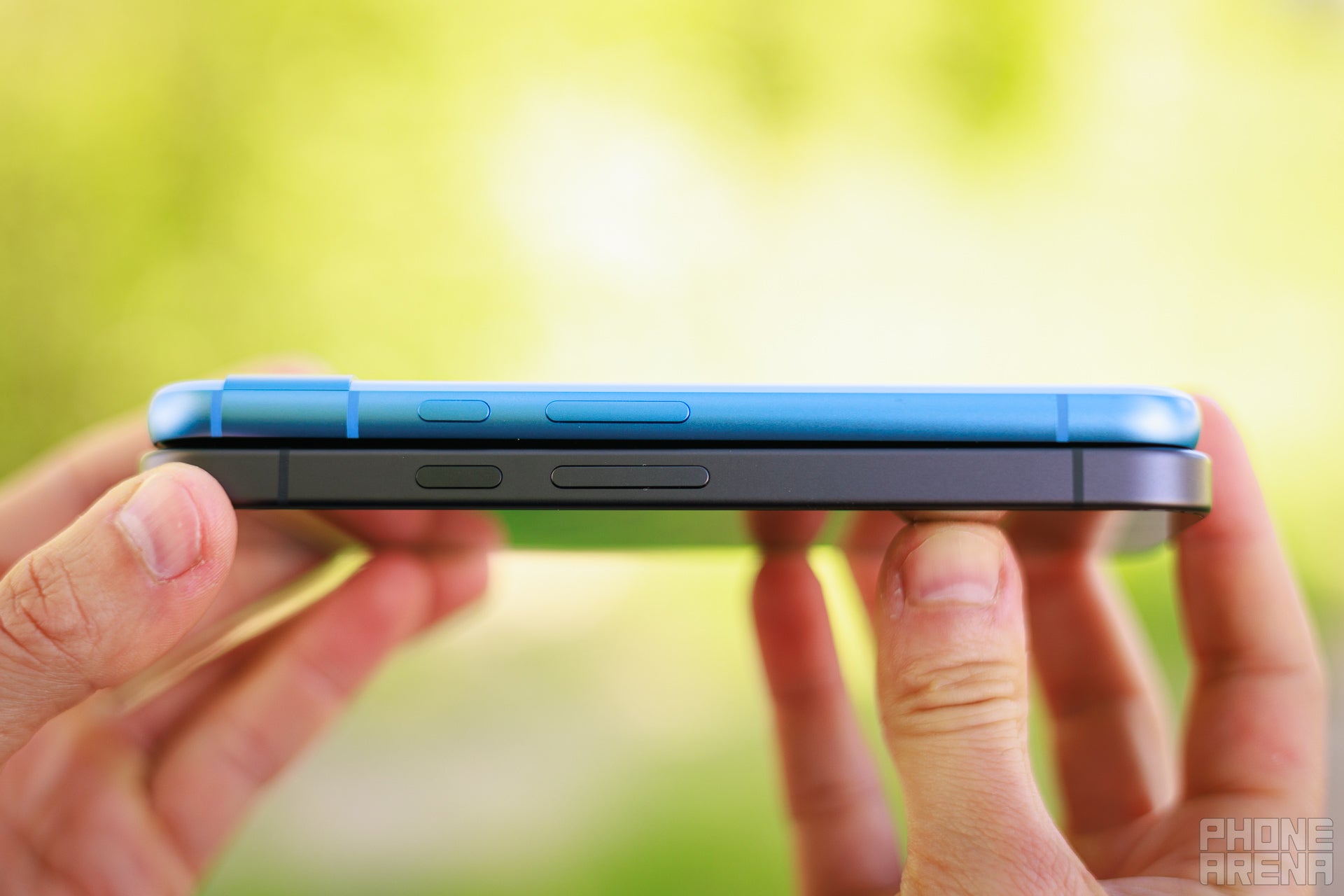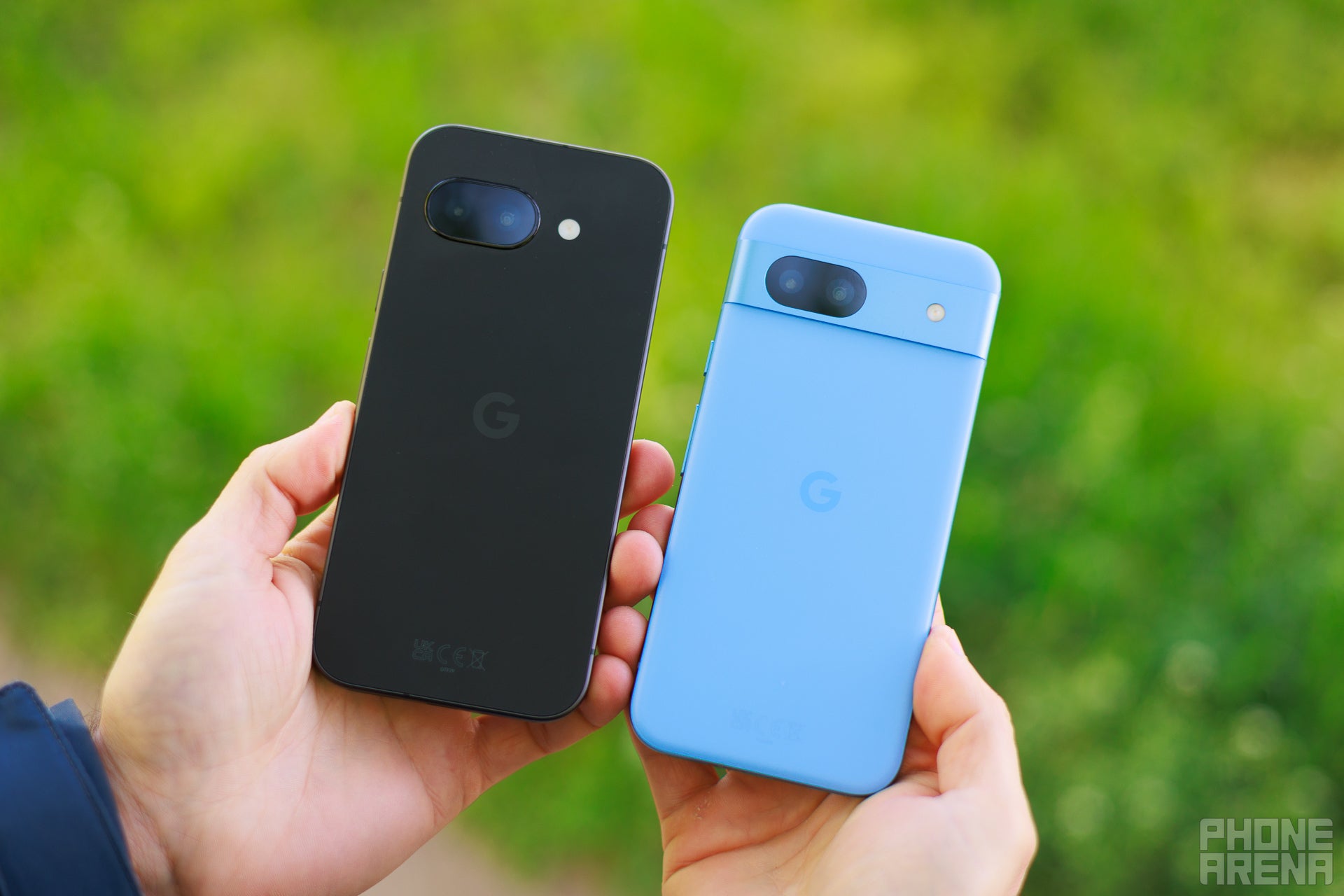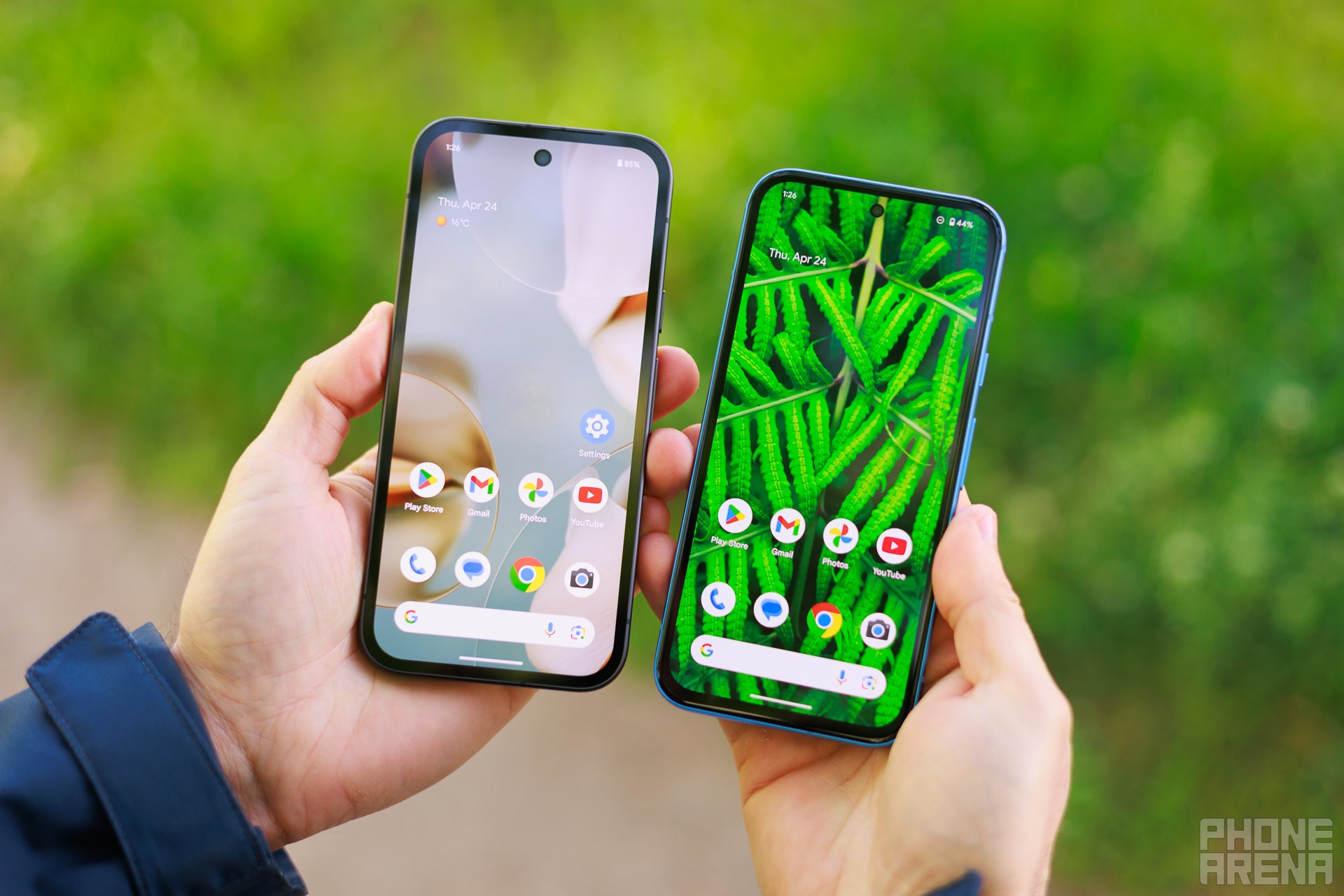Intro
Google’s new Pixel 9a is here, and honestly, it is easily the best-value Pixel ever revealed.
Pixel 9a vs Pixel 8a differences:
| Pixel 9a | Pixel 8a |
|---|---|
| Slightly larger, with the same flat design language as the Pixel 9 series | Also compact, but with a rear-curved design language |
| No protruding camera bump | Protruding 3D Camera Visor bump |
| Google’s latest Tensor G4 chip | The previous-gen Google Tensor G3 chip |
| Slightly larger 6.3-inch 60/120Hz OLED screen | More compact 6.1-inch 60/120Hz OLED panel |
| Brighter display (2,700 nits of peak brightness) | Lower peak brightness (2,000 nits) |
| 48MP F1.7 main camera with a 1/2″ sensor | 64MP F1.9 main camera with a 1/1.73″ sensor |
| Larger 5,100mAh battery | A smaller 4,492mAh battery |
| 23W wired charging, 7.5W wireless charging | 18W wired, 7.5W wireless charging |
| Starting at the same $499 price | Launched at $499 |
| IP68 water/dust resistance | IP67 water/dust resistance |
| Available in Iris, Peony, Porcelain, and Obsidian colors | Came in Obsidian, Porcelain, Bay, and Aloe colors |
Design and Size
Major design changes, seemingly all for the better!

(Image by PhoneArena)
Google has treated the Pixel 9a to a pretty serious glow-up that brings it closer to the Pixel 9 and Pixel 9 Pro. All curves are gone, substituted for a completely right-angled and flat design on all sides. That’s the trend these days, and it was time the affordable Pixel adopted it. The phone has an aluminum frame and a plastic back, which is okay––design materials are one of the few corners that are cut first.
The Pixel 8a, on the other hand, sports some slight curves, which look relatively old-school in the current phone environment. This design is definitely more ergonomic as no edges cave into your palm.
The Pixel 9a has also grown as Google has employed a slightly larger 6.3-inch display instead of the more compact 6.1-inch one on the older Pixel 8a. Bad news for all those who have enjoyed the slightly smaller form factor of the affordable Pixel line, but good news for just about anyone else.

(Image by PhoneArena)
With its new dimensions of 154.7 x 73.3 x 8.9mm, the Pixel 9a is slightly taller and wider than the Pixel 8a, which boasted dimensions of 152.1 x 72.2 x 8.9mm. This means that ergonomics might suffer a bit, but not by much.
What’s even more curious is the camera island at the rear, which appears to be mostly flush with the back panel. That’s a pretty stark change in comparison with the excessive camera strips that all recent Pixels have sported, as well as the Pixel 8a in particular. That’s a design choice we hope sticks around!

(Image by PhoneArena)
The Pixel 9a is an IP68-rated phone, which is an endurance rating a tad higher than the Pixel 8a‘s IP67. Dust resistance is similar, but you can dunk the Pixel 9a in deeper water and for longer in comparison with the older device.
The Pixel 9a is available in Obsidian (black), Porcelain (white), Iris (lavender/purple), and Peony (pink) colors, while the Pixel 8a was available in Aloe (green), Bay (blue), Porcelain (white), and Obsidian (black) colors.
Display Differences

(Image by PhoneArena)
As we mentioned, the Pixel 9a has scored a screen size bump to 6.3 inches, just like the Pixel 9. That’s a healthy increase of 0.2 inches in comparison with the Pixel 8a.
Aside from that, the screen remains an OLED one, with FHD+ resolution, and with adaptive 60/120Hz refresh rate (just like the Pixel 9). That’s pretty much identical with the older phone, but one area in which Google has greatly improved things is the maximum brightness.
While the older Pixel 8a can reach a peak brightness of 2,000 nits, the new Pixel 9a reaches above 2,500 nits of peak brightness in our tests, which definitely is practical with outdoor legibility. Other than that, we didn’t measure any other major differences here: both displays exhibit similar contrast, color, and gamma properties, so the big defining feature is the peak brightness itself.
Both phones feature embedded fingerprint scanners into the display, but also support picture-based face unlock.
Performance and Software
The usual suspects

(Image by PhoneArena)
The Tensor G4 is built on a 4nm manufacturing process, which means it’s absolutely decent and up to par with most other flagships these days. Sure, it doesn’t fare very well in synthetic benchmarks when compared to competitive chips as it’s optimized for on-device artificial intelligence and machine-learning, so it doesn’t really shine in synthetic benchmarks, but is absolutely decent in most real-life tasks.
CPU Performance Benchmarks:
Performance is surprisingly similar between the two devices. You are not getting much by going with the newer device, despite it technically boasting the newer Tensor G4 chipset on board.
In the graphics area, things are a bit more interesting. The Pixel 9a generally performs better than its predecessor, as indicated by the “high” 3DMark Extreme stress test, and also delivers more consistent graphics performance, as indicated by the “low” portion of the stress test.
Memory-wise, the Pixel 9a boasts 8GB of RAM and comes with 128GB or 256GB of storage. That’s the same memory configuration as the Pixel 8a, so nothing has changed.
Camera
New main camera

(Image by PhoneArena)
The Pixel 9a comes with a new 48MP camera, which might sound like a downgrade from the 64MP one on the Pixel 8a, but this isn’t the early 2000’s, so more megapixels don’t “automagically” mean a better camera.
The Pixel 9a comes with a 48MP F1.7 camera with 1/2.0″ sensor, dual-pixel autofocus and OIS, which sounds an awful lot like the main camera of the Pixel 9 Pro Fold. A pretty decent camera hardware, which would likely rank the Pixel 9a just in the midst of its peers.
Meanwhile, the Pixel 8a came with a very adept 64MP camera as well, with a slightly larger 1/1.73″ sensor. This camera delivered a pretty decent image quality, arguably one of the more notable ones in the affordable phone segment. Knowing Google, the Pixel 9a will either strike gold, too, or perform even better, which is great!
Both phones come with the same 13MP ultrawide camera with F2.2 aperture and 120-degree field-of-view.
Well, at the end of the day, despite the hardware differences, a rare intergenerational synergy has been achieved between the two phones: they deliver mostly the same results in both still photos and videos. Yep, both are awarded 134 points total in our camera tests, and although there are slight deviations in the results, you might as well assume that both take similar pictures and photos.
Video

Videos taken with either phone are, well, pretty similar, with comparable detail, dynamic range, and colors. You get the signature Pixel look here as well, and while the older Pixel delivers slightly richer color, the new Pixel 9a has ever-so-slightly better dynamic range. Pet peeves, those.
Battery Life and Charging
A very decent upgrade!

(Image by PhoneArena)
Google has put a pretty hefty 5,100mAh battery inside the Pixel 9a, which is an exceptional upgrade over the significantly smaller 4,492mAh battery inside the Pixel 8a and also a big upgrade from the 4,700mAh battery on the Pixel 9.
How does it all pan out for the Pixel 9a? Well, simply lovely! The phone achieves nearly 20 hours in our web browsing test, nearly 11 hours in the video-streaming one, and manages to stay afloat for 12 hours and 30 minutes in our arduous gaming test. Those are all excellent results that propel it to the very top of our Pixel battery chafrt hall of fame!
At the same time, the Pixel 8a delivers mostly average battery life thanks to the smaller battery and the less efficient Tensor G3. The Pixel 8a scored almost 14 hours in our browsing test, eight hours and a half in our video test, and a little over seven hours in our gaming test. Ultimately, not enough to compete against its successor.
PhoneArena Battery and Charging Test Results:
Charging-wise, we have also scored some upgrades. The Pixel 9a charges at up to 23W wired, while the older device supported just 18W of wired charging speed. We get similar 7.5W wireless charging speed on both phones, though.
Audio
Specs Comparison
| Google Pixel 9a | Google Pixel 8a | |
|---|---|---|
| Size, weight | 154.7 x 73.2 x 8.9mm, 186gr | 152.1 x 72.2 x 8.9mm, 188gr |
| Screen | 6.3″ FHD+ OLED 60/120Hz 2,700 nits peak brightness |
6.1″ FHD+ OLED 60/120Hz 2,000 nits peak brightness |
| Processor | Tensor G4, 4nm | Tensor G3, 4nm |
| RAM, Storage | 8GB/128GB 8GB/256GB |
8GB/128GB 8GB/256GB |
| Cameras | 48MP main 13MP ultrawide 13MP front |
64MP main 13MP ultrawide 13MP front |
| Battery | 5,100mAh | 4,492mAh |
| Charging | USB-C 23W wired 7.5W wireless |
USB-C 18W wired 7.5W wireless |
Summary

(Image by PhoneArena)
The Pixel 9a has the chance to swoop in and easily become the new value king in Google’s arsenal!
A larger display, significantly larger battery, faster chip, as well as a capable flagship-grade camera, but with the same unchanged price tag, might easily make it another smash-hit affordable success story for Google.
That said, the Pixel 8a is still a great phone and will remain so even after the arrival of the Pixel 9a. No matter how things play out, you probably shouldn’t consider upgrading, as the older Pixel still has a lot to offer.
However, those potentially eyeing the Pixel 9a as an entry-level point into the Pixel ecosystem might be in for a real value-for-money treat.











